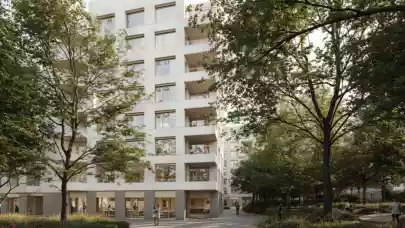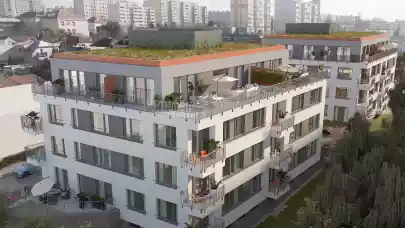
Adrian Pop, General Manager of ADP green building, talked to Property Forum about the demand for sustainability assessments of buildings and the company’s expansion into the ESG services segment, which is increasingly requested by real estate companies. In 2022 alone, the company completed 108 BREEAM certifications, more than double the previous year, for commercial projects across Romania.
This interview was first published in Property Forum’s annual listing of "The 50 most influential people on Romania’s real estate market”.
What business plans does ADP green building have for this year and what were your results for 2022?
In 2022 we doubled our activity, both in terms of number of contracted projects, number of completed projects, completed projects with notable results, turnover, profit and team.
This year is one of consolidation for us. We have renewed our collaborations with our main clients for the recertification of their portfolios, for projects planned for this year or even the years to come and we have extended our collaboration in other countries. We have secured a solid work pipeline for the next 2-3 years and requests for new projects continue to come in.
So far, our work has focused on the BREEAM certification, with all that it entails: consultancy, certification and related studies.
However, last year we recorded a more complex demand for ESG services. That is why we started to provide a number of new services: EU Taxonomy certification, WELL certification, carbon footprint calculation and decarbonisation plan, GRESB reporting energy modeling for nZEB compliance of buildings. All these are components of an ESG strategy.
How is the demand for green building certification services evolving in the context of accelerating real estate development under ESG principles?
The demand for building sustainability assessment emerged in 2010-2012, but was concentrated in the office building sector until 2018-2019. That is when investment funds and large building owners started to be interested in certifications and started certifying entire portfolios. It was a first step towards knowing the level of sustainability of existing portfolios, improving them over time and looking for the right situations to invest in landmark buildings.
Today, certifications such as LEED or BREEAM have extensive presence in the office, industrial and retail sectors. In the residential sector demand is extremely low, because the supply of residential space is too small compared to demand, and developers are not yet feeling the pressure to use a certified sustainability and quality standard from customers.
Instead, demand has started to emerge from public works. Our team is involved in the Cluj Children’s Hospital project and the rehabilitation of Teleki Castle in Comlod, projects of the County Councils of Cluj and Bistrița-Năsăud, respectively.
Which commercial real estate sectors have the highest green building score in Romania?
In general, the office building sector is the best performer. However, if we look at recent record scores, aside from offices there are more special projects such as CTP Clubhaus, the community facility in the CTPark Bucharest West industrial park, the PENNY Otopeni store, the PENNY Filiași logistics warehouse or the Children’s Hospital in Cluj.
How important is getting a green building certification for a real estate project looking for tenants or buyers?
It is not just the existence of a certification that is important, but, moreover, the score you get. Romania seems to be very competitive, with some of the highest scores in Europe or even the world every year for office, retail, residential, logistics or public buildings.
Tenants with many employees, such as those in office buildings, have started to demand, in addition to environmental certifications such as BREEAM and LEED, also WELL certifications, which are more focused on the comfort and health of people in buildings.
Buyers and financiers have started to demand certifications and sometimes even some minimum levels, because they know that a certification brings a building a better valuation, lower operating costs, better chances to rent or sell it later and, very importantly lately, a lower risk related to climate change adaptation.
What are the sustainability trends in the real estate sector and how are you adapting your services to these developments?
The demand for BREEAM certifications remains constant. This remains the core of our work, supported by key partnerships with owners of large building portfolios and a number of other one-off projects.
In 2022 we started to diversify the services we offer, with several collaborations currently in place for WELL certifications, EU Taxonomy, carbon footprint calculation and reduction, nZEB compliance, all components of an ESG strategy.
What were the key real estate projects where ADP green building provided services for sustainability certification in 2022?
In 2022, we completed 108 BREEAM certifications, more than double the previous year. This fairly high number is due to several partnerships where we use BREEAM assessment and certification as a method of verification for each project built by some of our partners: CTP, Mitiska REIM, PENNY Romania, Scallier, Transilvania Construcții.
Among the special projects of 2022 I can mention the HQ of Banca Transilvania in Cluj-Napoca, the Children’s Hospital in Cluj, the CTP Clubhaus community facility in the CTPark Bucharest West logistics park, the PENNY logistics warehouse in Filiași, the Unique Student Residence in Bucharest and the Paltim office building in Timișoara. All these projects have been awarded BREEAM Outstanding, post-construction or for the design stage.
How will new building compliance with nZEB standards influence the market for sustainability certifications of residential projects?
Improvements in sustainability certification scores will be observed not just for residential buildings but for the whole built environment. The nZEB regulations already apply to all buildings under development in Romania.
What are the most important factors in determining the sustainability score of a real estate project?
The sustainability of the built environment is a fairly broad and multi-disciplinary field. One of the strengths of building sustainability assessment standards is that they manage, to a large extent, to provide a framework that takes into account many factors, not necessarily some being more important than others, but together forming a holistic approach.
While at an average level of certification, the project team can choose between these factors and form a strategy to achieve the desired result, for the highest levels of certification, such as BREEAM Outstanding, all requirements need to be addressed, considerable investment and attention is required to meet all possible requirements at all stages of the project.
These are some of the main factors: energy efficiency, comfort of building users (thermal comfort, natural lighting, indoor air quality), mobility and accessibility, low water consumption, carbon footprint, efficient use of materials, waste management on site and in operation, biodiversity protection, pollution reduction, rainwater management or the sustainable management of site organization.



